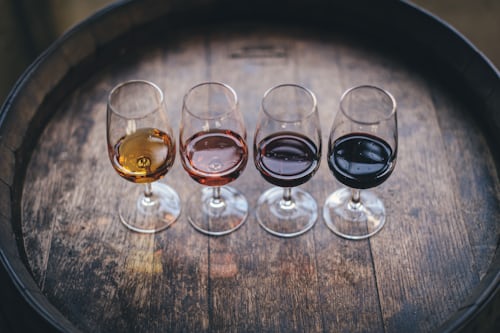There is not just a visual difference between red and white wine. Red and white wines have considerable differences in taste, maturation, and even at the molecular level. The differences between red and white wine are here. Do you know how to distinguish the red wine vs white wine taste?
The Differences of Red Wine and White Wine

Here are some of the differences between red wine and white wine, including the process and red wine vs white wine taste!
They are Made Differently
We all know the fundamentals. Wine comes from grapes — or rather from fermented grape juice. Then it follows that red wine is derived from red grapes and white grapes, right?
Not forcibly. Almost every grape produces clear juice, whether red or white. The secret to the color of a wine is not the pulp, but the skin. When making white wine, the surfaces of the grapes are removed before fermentation, which results in a clear juice, which produces a transparent white wine.
These skins are usually white, but many white wines (including a large portion of champagne) are made with red grapes — a so-called blanc de noir style.
On the other hand, the skins remain in contact with the juice as they ferment during red wine production. This process, called “maceration,” extracts the color and taste of red wine.
The Process of Winemaking
Everyone knows that grape wine, but how exactly? Like beer, natural fermentation produces wine. After grapes have been crushed, yeasts naturally interact with sugar and create alcohol in the grape juice. The fermentation process can last from three days to three years, depending on the wine style.
Although red wines are typically red and white wines (or a transparent muted yellow), they are not necessarily made from white grapes. In particular, the term “blanc de noir” refers to white wine made from red grapes. Actually, almost all grapes produce clear juice, so the grape type does not separate here.
White wines have a vast array of flavors. Also, some white wines are very sweet, while others are arid. White wine is light, fruity. White wines, fish, poultry, pork, and fruit together. Red wines are usually on the bitter side with a porous taste. Moreover, red wine is bolder and sophisticated. Red wines are good for beef, pork, chocolate, and cheeses.
The Tannins Matter

What affects the red wine vs white wine taste? Tannin makes the taste of wine dry or bitter. More specifically, it is a herbal substance that binds proteins and amino acids and gives the red wine the pucker’s feeling when you drink it. Little or no tannins have white wines. Tannins are found in the skin of the grape that is removed during the production of white wine. The absence of tannins gives a sweeter, lighter taste to white wine.
Red wines have huge quantities of tannins. The grapes’ skin is left in the process of producing red wine, which puts tannins into the juice. Some winemakers also use grape seeds, which is another essential tannin source. These molecules have a bitter taste for red wine. It is also responsible for red wine’s mouthfeel. Moreover, the mouthfeel is a term for your mouth’s pucking feeling when you drink red wine.
The first one should be self-explaining. Simply put, red and white wines tend to evoke a variety of tastes. While it’s difficult to generalize, reds typically invoke fruit in the beers family, from strawberries and cherries (in lighter reds) to cassis, blackberries and plumb in richer ones. Sometimes, we may have “secondary” flavors (i.e., non-fruit), such as herbs, tobacco, or leather, which add dimension.
In the case of whites, gamut ranges from citrus fruits (for lighter, shinier phrases) to orchard fruits (thought of pears, apples), and even exotics, such as guava, mango, and pineapple, grow up in intensity. Some white wines are briny or chalky, often described as “mineral,” while rich whites may acquire secondary oily or nutritious flavors and aromas.
More Information
The structure concept is more difficult to define. Basically, the relationship between all the elements determines how a wine actually felt in your mouth. Is it fresh, crisp, or wide and plucky? Gentle or sharp? Light or heavy?
In addition to the beautiful pigment, the skins of red grapes also provide the main structural component of red wine: tannins. In many plants, tannins are the astringent phenolic compounds, including grape skins. If you have ever been bitter in an apple peel and felt your mouth pucker, you already know its effects.
Tannins function as a red wine skeleton that provides the backbone to build its complex tastes. They also help maintain red wines, which allow them to age longer than most whites.
Since white wine is fermented without contact with the skin, tannins don’t really contribute to the equation. Acidity, however, plays an enhanced role in the white wine structure. Three primary acids are found in wine — malic, tartaric, and citric — and are mostly more marked in whites than in reds. This spine of acidity is a tart, crisp profile of white wine; it also accentuates the underlying aromas of the wine and helps pair it with the food, a bit like a squeeze of lemon.
They Pair With Different Foods

One more thing about red wine vs white wine taste is that they have different pairings. Conventional knowledge teaches us to drink white with light meals, such as seafood and veggies, and red wine with heavier meat dishes. This makes sense, of course. Who could deny the harmony between a fatty, heartfelt steak and a large bottle of Cabernet or a plate of citrus mousse and a fresh, refreshing white Sauvignon?
However, these pairings have emerged as classics not for any authoritative reason but from an intuitive understanding of how various wine styles interact with the various food components, such as fat, salt, sugar, and acidity. The key is to match additional flavors and textures.
The traditional “white with fish, red with meat” mantra is, for the most part, in line with this fundamental principle — but not always. For example, if cooked in a pungent sauce that calls for an earthy red, a fleshier, fatter fish, such as salmon, does not always have to be paired with white wine. Likewise, pineapple-glazed beef skewers in a peanut-chili dipping sauce could be better with a white exotic.
More Information
The differences are subtler here. Although difficult to generalize, red wine is often linked to fruits in the beer family, with sometimes secondary tastes such as herbs and tobacco leaves. White people instead invoke aromas such as citrus fruits, orchards, or tropical fruits.
White wines are also more acidically recognizable. The three major wine acids are malic, tartaric, and citric, all of which is white wine is more pronounced. Acidity contributes to the flavors of wine and greatly affects the combinations of food.
What foods can be combined with white and red wines? White wine is generally more appropriate for light foods and red wine for heavier foods. This enables wines to complete courses but does not take food away or overwhelm the person who tastes it. There are more nuanced reasons, however, and a detailed wine pairing chart is available here. No wonder the whole college course can be tasted with wine!
What Makes Red Wine Appear Red?

Red wine gets its dark grape skin color. Whereas grape juice is usually colorless, almost all pigmentation is present in grape skin. To produce white wine producers, the grape skins must be removed before fermentation. The skins must ferment with the juice for red wine, a process called “maceration.”
The grape skin removed prior to fermentation also contains a chemical compound called tannin that leads to further differences between red and white wines. The red wine gives its typical dryness or astringency, which distinguishes it from white wine. Tannins are also a natural antioxidant that makes red wines older than white. In fact, white winemakers can add fining agents to the juice to remove tannins more.
Red And White Wine Benefits
Red and white wines are good for your well-being. Even if they are made with grapes, they are not as healthy as the fruit. The grapes will lose some of their nutrition after fermentation while offering different health benefits. One of the main advantages of white wine is its ability to improve lung health, prevent heart condition, and improve cardiovascular health.
The majority of white wines have health benefits, but can also contribute in other ways. As red varieties have grape skins, they have a strong antioxidant form called resveratrol. This resveratrol provides excellent blood vessel protection and can even help eliminate blood clots. Red wines contain polyphenols that are important antioxidants for different purposes.
Polyphenols reduce the level of blood pressure and cholesterol, fight harmful bacteria, and improve the immune system. There are also a large number of flavonoids in red varieties that can help decrease the risk of cancer.
Final Words
Both red and white wines improve your physical health, but they can even help you overcome mental health problems. If you have stress, either type of calming effect can help you overcome it and help you cure diseases. Hopefully, this red wine vs white wine taste can help you decide what wine is best for you!






